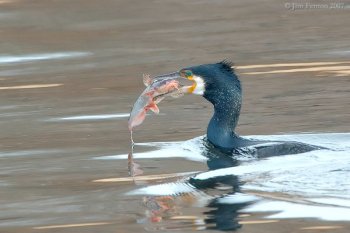Bible Birds – Cormorants

Double-crested Cormorant (Phalacrocorax auritus) By Dan’sPix
But the cormorant and the bittern shall possess it; the owl also and the raven shall dwell in it: and he shall stretch out upon it the line of confusion, and the stones of emptiness. (Isa 34:11)
And the little owl, and the cormorant, and the great owl, (Leviticus 11:17 KJV)
CORMORANTS. Phalacrocoracidæ. – Bill with a hooked tip; a small pouch at its base; plumage usually black or blackish.
Cormorants nest in large colonies, generally on isolated islets, but sometimes in remote swamps. The nests are placed closely together on the ground, in bushes, and less frequently in trees, according to the nature of the bird’s haunts.
Cormorants feed on fish which they catch by pursuing them under the water. They dive from the surface of the water like Ducks, or from a low perch, but not from the air, as do the Gannets.
*
*
The members of this Order agree in having all four toes connected by webs, but in other respects they differ widely in structure and, consequently, in habit. The young of all the Steganopodes are born naked, unlike the young of most of the other water birds, which, as a rule, are hatched covered with feathers and can swim or run about soon after birth. The nests of the Steganopodes are, of necessity, therefore, more complex structures than those of birds whose nests are merely incubators and not cradles as well.
*
To find out more about Cormorants:
- Birds of the Bible – Cormorant
- Birds of the Bible – Cormorant II
- Cormorant Photos
- Cormorant Videos
- Cormorant Videos by Nick and Keith
- Nave’s Topical Bible – Cormorant
- Cormorants and Shag – Phalacrocoracidae Family
Links from WhatBird.com and Wikipedia.com:
- Brandt’s Cormorant – WhatBird * Wikipedia
- Double-crested Cormorant – WhatBird * Wikipedia’s
- Great Cormorant – WhatBird * Wikipedia
- Neotropic Cormorant – WhatBird * Wikipedia
- Pelagic Cormorant – WhatBird * Wikipedia
- Red-faced Cormorant – WhatBird * Wikipedia
- Link to Wikipedia – Cormorant
*
*
An alphabetical list of the Phalacrocoracidae – Cormorants, shags Family:
Antarctic Shag (Leucocarbo bransfieldensis)
Auckland Shag (Leucocarbo colensoi)
Australian Pied Cormorant (Phalacrocorax varius)
Bank Cormorant (Phalacrocorax neglectus)
Black-faced Cormorant (Phalacrocorax fuscescens)
Bounty Shag (Leucocarbo ranfurlyi)
Brandt’s Cormorant (Phalacrocorax penicillatus)
Bronze Shag (Leucocarbo chalconotus)
Campbell Shag (Leucocarbo campbelli)
Cape Cormorant (Phalacrocorax capensis)
Chatham Shag (Leucocarbo onslowi)
Crowned Cormorant (Microcarbo coronatus)
Crozet Shag (Leucocarbo melanogenis)
Double-crested Cormorant (Phalacrocorax auritus)
European Shag (Phalacrocorax aristotelis)
Flightless Cormorant (Phalacrocorax harrisi)
Great Cormorant (Phalacrocorax carbo)
Guanay Cormorant (Leucocarbo bougainvillii)
Heard Island Shag (Leucocarbo nivalis)
Imperial Shag (Leucocarbo atriceps)
Indian Cormorant (Phalacrocorax fuscicollis)
Japanese Cormorant (Phalacrocorax capillatus)
Kerguelen Shag (Leucocarbo verrucosus)
Little Black Cormorant (Phalacrocorax sulcirostris)
Little Cormorant (Microcarbo niger)
Little Pied Cormorant (Microcarbo melanoleucos)
Macquarie Shag (Leucocarbo purpurascens)
Neotropic Cormorant (Phalacrocorax brasilianus)
Pallas’s Cormorant (Phalacrocorax perspicillatus)
Pelagic Cormorant (Phalacrocorax pelagicus)
Pitt Shag (Phalacrocorax featherstoni)
Pygmy Cormorant (Microcarbo pygmeus)
Red-faced Cormorant (Phalacrocorax urile)
Red-legged Cormorant (Phalacrocorax gaimardi)
Reed Cormorant (Microcarbo africanus)
Rock Shag (Phalacrocorax magellanicus)
Rough-faced Shag (Leucocarbo carunculatus)
Socotra Cormorant (Phalacrocorax nigrogularis)
South Georgia Shag (Leucocarbo georgianus)
Spotted Shag (Phalacrocorax punctatus)
White-breasted Cormorant (Phalacrocorax lucidus)
*
But the cormorant and the bittern shall possess it; the owl also and the raven shall dwell in it: and he shall stretch out upon it the line of confusion, and the stones of emptiness. (Isa 34:11)

